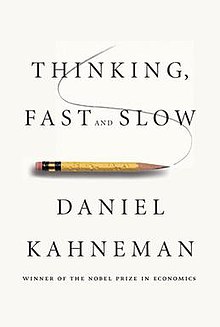 Hardcover edition | |
| Author | Daniel Kahneman |
|---|---|
| Language | English language |
| Subject | Psychology |
| Genre | Non-fiction |
| Publisher | Farrar, Straus and Giroux |
Publication date | 2011 |
| Publication place | United States |
| Media type | Print (hardcover, paperback), audio |
| Pages | 499 pages |
| ISBN | 978-0374275631 |
| OCLC | 706020998 |
Thinking, Fast and Slow is a 2011 popular science book by psychologist Daniel Kahneman. The book's main thesis is a differentiation between two modes of thought: "System 1" is fast, instinctive and emotional; "System 2" is slower, more deliberative, and more logical.
The book delineates rational and non-rational motivations or triggers associated with each type of thinking process, and how they complement each other, starting with Kahneman's own research on loss aversion. From framing choices to people's tendency to replace a difficult question with one which is easy to answer, the book summarizes several decades of research to suggest that people have too much confidence in human judgment.[1] Kahneman performed his own research, often in collaboration with Amos Tversky, which enriched his experience to write the book.[2][3] It covers different phases of his career: his early work concerning cognitive biases, his work on prospect theory and happiness, and with the Israel Defense Forces.
The book was a New York Times bestseller[4] and was the 2012 winner of the National Academies Communication Award for best creative work that helps the public understanding of topics in behavioral science, engineering and medicine.[5] The integrity of some priming studies cited in the book has been called into question in the midst of the psychological replication crisis.[6]
- ^ Shaw, Tamsin (April 20, 2017). "Invisible Manipulators of Your Mind". New York Review of Books. ISSN 0028-7504. Retrieved August 10, 2020.
- ^ Holt, Jim (November 27, 2011). "Two Brains Running". The New York Times. p. 16.
- ^ Daniel Kahneman (2011). Thinking, Fast and Slow. Macmillan. ISBN 978-1-4299-6935-2. Retrieved April 8, 2012.
- ^ "The New York Times Best Seller List – December 25, 2011" (PDF). www.hawes.com. Retrieved August 17, 2014.
- ^ Cite error: The named reference
NASwas invoked but never defined (see the help page). - ^ Schimmack, Ulrich (December 30, 2020). "A Meta-Scientific Perspective on "Thinking: Fast and Slow". Replicability-Index. Retrieved February 11, 2023.